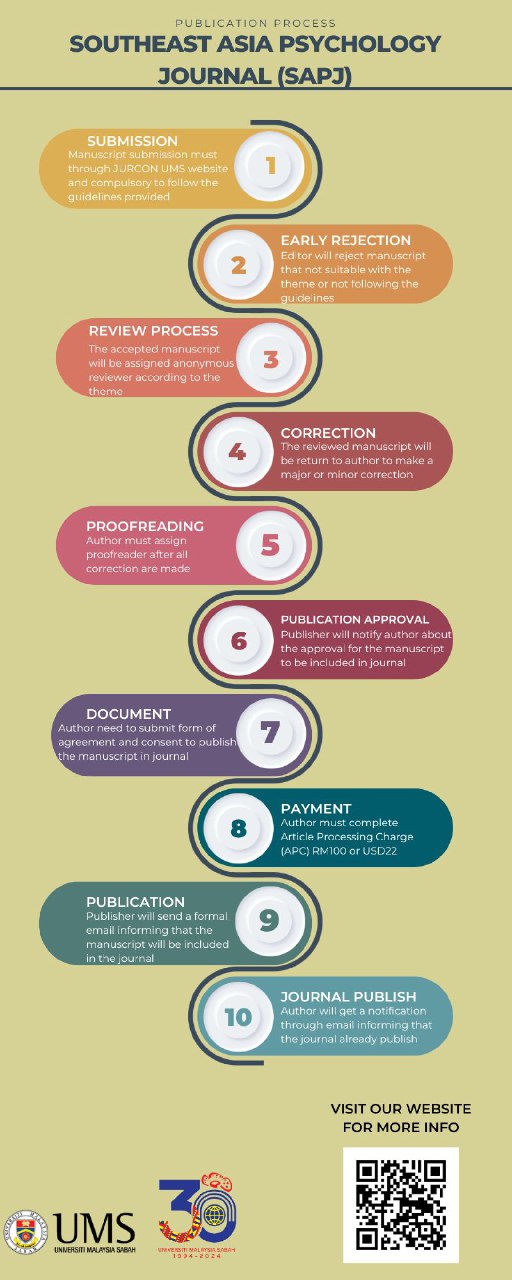READINESS TO QUIT SMOKING AMONG REGISTERED SMOKERS AT THE QUIT SMOKING CLINIC SERVICES IN MALAYSIA
DOI:
https://doi.org/10.51200/sapj.v11i1.4891Keywords:
Readiness to Quit Smoking, Social support, Nicotine Dependence, Hospital’s PatientsAbstract
The Quit Smoking Clinic Services (QSCS) service at government hospitals is provided by the Ministry of Health Malaysia to help smokers quit smoking. Therefore, information on socio-demographic characteristics, smoking profiles and factors that correlate with the readiness to quit smoking is important. This study was conducted to identify factors that correlate with the readiness to quit smoking. A total of 115 respondents were involved in this study. Social support from friends has a significant negative correlation with willingness to quit smoking (r=-0.224). For the willingness to quit smoking construct, there is a significant negative correlation between social support from the family and the pre-contemplation construct score (r=-0.179), there is a negative significant correlation between the nicotine dependence score and the contemplation construct score (r=-0.180), there is a significant negative correlation between social support from friends with the action construct score (r=0.183) and there is a significant negative correlation between social support as a whole and social support from friends with the behavior maintenance construct (r=-0.206, r=-0.305). Therefore, the results of this study have the potential to be used as the basis reference for the development of special guidelines that focus on empowering smokers against external influences to quit smoking. In addition, factors such as socio-demographic characteristics, nicotine dependence, social support, play an important role in each stage of readiness to quit smoking. Special modules of behavioural treatment interventions involving social support and using available resources are needed to ensure that smoking treatment given is appropriate. Thus, assessment study using biopsychosocial and spiritual perspectives should also be conducted in Malaysia so that an understanding of the issues faced by smokers to quit smoking can be clearly understood holistically.
References
Avicenna, M. & Rafaei, W.A.R. 2010. The correlation of health related quality of life with
psychological distress, social support, and cognitive coping in chronic pain patient. The Journal of Behavioural Science, 3(1), 31-44. https://so06.tci-thaijo.org/index.php/IJBS/article/view/2161
Health Education Division. 2005. Manual Latihan Kebangsaan: “Membantu perokok berhenti merokok” untuk Profesional Kesihatan di Klinik Berhenti Merokok, Hospital, dan Klinik Kesihatan. Ministry of Health Malaysia.
Barrueco, M., Otero, M.J., Palomo, L., Ruiz, C.J., Torrecilla, M., Romero, P., & Riesco, J. A. 2005. Adverse effects of pharmacological therapy for nicotine addiction in smokers following a smoking cessation program. Nicotine and Tobacco Research, 7(3), 335–342. https://doi.org/10.1080/14622200500124768
Blanchard, K.A., Morgenstern, J., & Morgan, T.J. 2003. Motivational subtypes and continuous measures of readiness for change: Concurrent and predictive validity. Psychology of Addictive Behaviours, 17(1), 56–65. https://psycnet.apa.org/doi/10.1037/0893-164X.17.1.56
Brodish, P.H. & Ross, G.L. 1998. The irreversible health effects of cigarette smoking. American Council on Science and Health. https://www.acsh.org/wp-content/uploads/2012/04/20040402_Irreversible_Effects1998.pdf
Cheng, S.T. & Chan, A.C.M. 2004. The multidimensional scale of perceived social support: Dimensionality and age and gender differences in adolescents. Personality and Individual Differences, 37(7), 1359-1369. https://doi.org/10.1016/j.paid.2004.01.006
Daoud, N., Hayek, S., Muhammad, A.S., Abu-Saad, K., Osman, A., Thrasher, J.F., & Leibovici, K.O. 2015. Stage of change of the readiness to quit smoking among random sample of minority Arab-male smokers in Israel. BMC Public Health, 15(672). https://doi.org/10.1186/s12889-015-1950-8
Debra, E.D., & Velasco, M.G. 2007. Southeast Asia Tobacco Control Alliance - Protecting the right to lofe: promoting smoke free public places in ASEAN. Bangkok.
DiClemente, C.C., & Hughes, S.O. 1990. Stages of change profiles in alcoholism treatment. Journal of Substance Abuse, 2(2), 217–235. https://doi.org/10.1016/S0899-3289(05)80057-4
DiClemente, C.C., Schlundt, D., & Gemmell, L. 2004. Readiness and stages of change in addiction treatment. American Journal on Addictions, 13(2), 130-19. https://doi.org/10.1080/10550490490435777
Doe, J., & DeSanto, C. 2009. Smoking’s immediate effects on the body. Campaign for Tobacco-Free Kids. https://www.tobaccofreekids.org/assets/factsheets/0264.pdf
Eriksen, M., Mackay, J., Schluger, N., Gomeshtapeh, F.I. & Drope, J. 2015. The Tobacco Atlas (5th ed.). Atlanta: American Cancer Society.
Figueiró, L.R., Bortolon, C.B., Benchaya, M.C., Bisch, N.K., Ferigolo, M., Barros, H.M.T., & Dantas, D.C.M. 2013. Assessment of changes in nicotine dependence, motivation, and symptoms of anxiety and depression among smokers in the initial process of smoking reduction or cessation: A short-term follow-up study. Trends in psychiatry and psychotherapy, 35(3), 212-220. https://doi.org/10.1590/S2237-60892013000300008
Foong, K. & Tan, Y.L. 2008. Smoking in girls and young women in Malaysia. National Poison Centre Universiti Sains Malaysia. https://www.seatca.org/dmdocuments/Smoking%20in%20Girls%20and%20Women%20in%20Malaysia.pdf
Gamberino, W.C., & Gold, M.S. 1999. Neurobiology of tobacco smoking & other addictive disorders. The Psychiatric Clinics of North America, 22(2), 301-312. https://doi.org/10.1016/S0193-953X(05)70078-2
Han, Y.W., Mohammad, M., & Liew, S.M. 2014. Effectiveness of a brief physician counselling session on improving smoking behaviour in the workplace. Asian Pacific Journal of Cancer Prevention, 15(17), 7287-7290. https://doi.org/10.7314/APJCP.2014.15.17.7287
Harker, K., & Cheeseman, H. 2016. The Stolen Years: The mental health and smoking action report. London, United Kingdom: Action on Smoking and Health. https://ash.org.uk/information-and-resources/reports-submissions/reports/the-stolen-years/
Heatherton, T.F., Kozlowski, L.T., Frecker, R.C. & Fagerström, K.O. 1991. The Fagerström test for nicotine dependence: A revision of the Fagerström Tolerance Questionnaire. British Journal of Addiction, 86(9), 1119-1127. https://doi.org/10.1111/j.1360-0443.1991.tb01879.x
Institute of Public Health. 2008. The Third National Health and Morbidity Survey [NHMS III]: Smoking. Ministry of Health Malaysia. http://www.iku.gov.my/images/IKU/Document/REPORT/2006/Smoking.pdf
Institute for Public Health Malaysia. 2011. Report of the Global Adult Tobacco Survey (GATS) Malaysia. Ministry of Health Malaysia. https://www.who.int/tobacco/surveillance/survey/gats/malaysia_country_report_2011.pdf
Institute for Public Health Malaysia. 2015. National Health and Morbidity Survey (NHMS): Report on smoking status among Malaysia adults. Ministry of Health Malaysia. https://www.moh.gov.my/moh/resources/NHMS2015-VolumeV.pdf
Institute for Public Health Malaysia. 2020. National Health and Morbidity Survey (NHMS) 2019: Vol. I: NCDs – Non-Communicable Diseases: Risk Factors and other Health Problems. National Institutes of Health, Ministry of Health Malaysia. Malaysia. 2019, 1, 80-83
Jochelson, K. & Majrowski W. 2006. Clearing the air: Debating smoke free policies in psychiatric units. London, United Kingdom: King’s Fund. https://www.kingsfund.org.uk/sites/default/files/field/field_publication_file/clearing-the-air-debating-smoke-free-policies-psychiatric-units-karen-jochelson-bill-majrowski-kings-fund-18-july-2006.pdf
Koning, P., Webbink, D., & Martin, N.G. 2010. The effect of education on smoking behaviour : New evidence from smoking durations of a sample of twins. Empirical Economics, 48, 1479-1497. https://doi.org/10.1007/s00181-014-0842-6
Ku, L., Brantley, E., Bysshe, T., Steinmetz, E. & Bruen, B.K. 2016. How Medicaid and other public policies affect use of tobacco cessation therapy, United States 2010-2014. Preventing Chronic Disease, 13(150), 1-9. https://dx.doi.org/10.5888%2Fpcd13.160234
Kviz, F.J., Clark, M.A., Crittenden, K.S., Freels, S., Warnecke, R.B. 1994. Age and readiness to quit smoking. Preventive Medicine, 23(2), 211–222. https://doi.org/10.1006/pmed.1994.1029
Lim, K., Amal, N., Norhamimah, A., Sumarni, M., Rozita, W.W. & Hanjeet, K. 2006. Smoking among form five students Kota Tinggi, Johor, Malaysia: Knowledge, attitude and smoking status at one year follow-up. Asia Pacific Family Medicine, 6(2), 31-37. https://www.mjphm.org.my/mjphm/journals/Volume%206%20(2)%20:%202006/31-37.pdf
Lim, K.H., Normala, I., Sumarni, M.G., Kee, C.C., Lim, K.K., Chan, Y.Y., Teh, C.H., Tee, E.O., Lai, W.Y., Mohd Haniki, N.M., & Sherina, M.S. 2013. Stages of smoking cessation among Malaysian Adults – Findings from National Health Morbidity Survey 2006. Asian Pacific Journal of Cancer Prevention, 14(2), 805-810. https://doi.org/10.7314/APJCP.2013.14.2.805
Ma, G.X., Shive, S.E., Toubbeh, J., Tan, Y., & Zhao, S. 2003. Social influences and smoking behaviours among four Asian American subgroups. Californian Journal of Health Promotion, 1(3), 123–134. https://doi.org/10.32398/cjhp.v1i3.2109
McConnaughy, E.A., Prochaska, J.O., & Velicer, W.E. 1983. Stages of change in psychotherapy: Measurement and sample profiles. Psychotherapy: Theory, Research and Practice, 20(3), 368-375. https://psycnet.apa.org/doi/10.1037/h0090198
McManus, S., Meltzer, H., & Campion, J. 2010. Cigarette smoking and mental health in England: Data from the Adult Psychiatric Morbidity Survey 2007. National Centre for Social Research. https://www.natcen.ac.uk/media/21994/smoking-mental-health.pdf
Ministry of Health Malaysia. 2015. Kenali infoline berhenti merokok. Health Education Division. http://taknak.myhealth.gov.my/infoline-berhenti-merokok/
Muhammad Faizal, M., Ali, A.M., Amit, N., Bakry, M.M., & Taha, N.A. 2016. Suitability of a group behavioural therapy module for workplace smoking cessation programs in Malaysia: A pilot study. Asian Pacific Journal of Cancer Prevention, 17(1), 207–214. https://doi.org/10.7314/APJCP.2016.17.1.207
Muhammad Rizwan & Neelma Syed. 2010. Urdu translation and psychometric properties of Social Provision Scale. The International Journal of Educational and Psychological Assessment, 4, 33-47.
Ng, C.G., Siddiq, A.N., Aida, S.A., Zainal, N.Z. & Koh, O.H. 2011. Validation of the Malay version of the Multidimensional Scale of Perceived Social Support (MSPSS-M) among a group of medical students in Faculty of Medicine, University Malaya. Asian Journal of Psychiatry, 3(1), 3-6. https://doi.org/10.1016/j.ajp.2009.12.001
Nur Asikin, A. 2017. Faktor klien cicir rawatan di Klinik Berhenti Merokok di tiga buah hospital berpakar di Kedah [Pembentangan tesis sarjana]. Fakulti Sains Kesihatan, Universiti Kebangsaan Malaysia.
Redmond, W.H. 1996. Product disadoption: Quitting smoking as a diffusion process. Journal of Public Policy and Marketing, 15(1), 87-97. https://doi.org/10.1177%2F074391569601500108
Royal College of Physicians of London. 2007. Harm reduction in nicotine addiction: Helping people who can’t quit. A report by the Tobacco Advisory Group of the Royal College of Physicians. London: RCP. https://cdn.shopify.com/s/files/1/0924/4392/files/harm-reduction-nicotine-addiction.pdf?15599436013786148553
Saravanan, C., & Heidhy, I. 2014. Psychological problems and psychosocial predictors of cigarette smoking behaviour among undergraduate students in Malaysia. Asian Pacific Journal of Cancer Prevention, 15(18), 7629-7634. https://doi.org/10.7314/APJCP.2014.15.18.7629
Scollo, M.M., & Winstanley, M.H. 2019. Tobacco in Australia: Facts and issues (4th ed.). Melbourne: Cancer Council Victoria. https://www.tobaccoinaustralia.org.au/
Shadel, W.G., Shiffman, S., Niaura, R., Nichter, M., & Abrams, D.B. 2000. Current models of nicotine dependence: What is known and what is needed to advance understanding of tobacco etiology among youth. Drug & Alcohol Dependence, 59(1), 9-22. https://doi.org/10.1016/S0376-8716(99)00162-3
Subramaniam, M., Shahwan, S., Fauziana, R., Satghare, P., Picco, L., Vaingankar, J.A., & Chong, S.A. 2015. Perspectives on smoking initiation and maintenance: A qualitative exploration among singapore youth. International Journal of Environmental Research and Public Health, 12(8), 8956–8970. https://doi.org/10.3390/ijerph120808956
Teoh, H.J. & Tam, C.L. 2008. A comparison of headache and non-headache sufferers on measures of social support health problems. Malaysian Family Physician, 3(2): 82-86. https://www.ncbi.nlm.nih.gov/pmc/articles/PMC4170315/pdf/MFP-03-82.pdf
Tsai, Y.W., Wen, Y.W., Tsai, C.R., & Tsai, T.I. 2009. Peer pressure, psychological distress and the urge to smoke. International Journal of Environmental Research and Public Health, 6(6), 1799–1811. https://doi.org/10.3390/ijerph6061799
Waite, L., & Gallagher, M. 2000. The case for marriage: Why married people are happier, healthier and better off financially. New York: Doubleday.
Wee, H.L., Hsien, C.C.M. & Nantha, Y.S. 2016. A review of smoking research in Malaysia. Medical Journal of Malaysia, 71(1), 29–41. http://e-mjm.org/2016/v71s1/smoking-research.pdf
World Health Organization. 2015. WHO global report on trends in prevalence of tobacco smoking 2015. World Health Organization. http://apps.who.int/iris/bitstream/10665/156262/1/9789241564922_eng.pdf?ua=1
World Health Organization. 2016. Psychological and mental health first aid for all. World Federation for Mental Health. https://www.who.int/mental_health/world-mental-health-day/paper_wfmh_2016.pdf
Zainol Abidin, Z.,N., Zulkifli, A., Rasdi, I., Syed Ismail, S.N., Abd Rahman, A., Hashim, Z., & Semple, S. 2014. Knowledge, attitude and perception of second-hand smoke and factors promoting smoking in Malaysian adolescents. International Journal of Tuberculosis and Lung Disease, 18(7), 856-861. https://doi.org/10.5588/ijtld.13.0906
Joly B, Perriot J, d’Athis P, Chazard E, Brousse G, Quantin C. 2017 Success rates in smoking cessation: Psychological preparation plays a critical role and interacts with other factors such as psychoactive substances. PLoS ONE 12(10): e0184800. https://doi.org/10.1371/journal.pone.0184800







